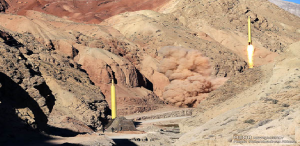
Iranian general boasts, “The reason we designed our missiles with a range of 2,000 kilometers is to be able to hit our enemy, the Zionist regime, from a safe distance.”
By Associated Press & Israel Hayom Staff
Iran test-fired two ballistic missiles at a target some 1,400 kilometers (870 miles) away, with the phrase “Israel must be wiped out” written on them, Iran’s semiofficial Fars News Agency reported on Wednesday.

A Qadr H long-range ballistic surface-to-surface missile is fired by Iran’s Revolutionary Guard in an undisclosed location in Iran, March 9, 2016 – Photo: AP
Fars offered pictures it said were of the Qadr H missiles being fired.
According to Brig. Gen. Amir Ali Hajizadeh, head of the Revolutionary Guard’s aerospace division, Iran’s medium-range ballistic missiles are designed to be able to hit Israel.
“The reason we designed our missiles with a range of 2,000 kilometers [1,200 miles] is to be able to hit our enemy the Zionist regime from a safe distance,” Hajizadeh was quoted as saying by the Iranian Students News Agency.
The announcement of the rocket fire comes as U.S. Vice President Joe Biden visits Israel as part of a Middle East tour. It also comes after a U.S. State Department spokesman on Tuesday criticized another missile launch, saying America planned to bring it before the United Nations Security Council.
On Tuesday, Iran’s Revolutionary Guard said it had recently launched several medium-range and short-range ballistic missiles as part of a military exercise, with ranges of between 300 and 2,000 kilometers (190 to 1,200 miles).
The longer ends of that range appear to exceed limits that the U.N. Security Council has imposed in connection to resolutions banning Iran from developing missiles capable of carrying nuclear warheads. Iran says none of its missiles are designed to carry nuclear weapons.
Obama administration spokesmen said it was aware of reports of the launch but could not confirm. They said that if the launches did occur, they would seek redress at the Security Council.
Asked whether the secretary-general condemned the latest missile launches, U.N. spokesman Stephane Dujarric said the U.N. was looking into the reports and it was up to the Security Council to determine whether there were any violation.
“It’s important that Iran live up to its obligations under the [nuclear] deal,” he said.
The U.N. experts panel said last year that a missile with a range of at least 300 kilometers (190 miles) and a payload of at least 500 kilograms (1,100 pounds) is considered by expert guidelines to be capable of delivering weapons of mass destruction
The Revolutionary Guard website said the missiles launched during the exercises included the midrange Shahab-1 and -2, and the multiple warhead Qiam, with a range of 800 kilometers, and the liquid-fueled Qadr F, which reportedly has a range of nearly 2,000 kilometers. It did not give the rockets’ payload capacity.
The missiles have been in service in the Guard over the past years.
The Islamic Republic News Agency said the missiles, launched from silos in several locations across the country, demonstrated Iran’s “deterrence power” and its readiness to confront threats. Iranian state TV ran what it said was video footage of the operation, showing missiles in underground silos and flashes of light from nighttime launches.
“Israel is afraid of the missile launch since it is in range of most of our missiles. Naturally, whoever has hostility towards Iran is in fear,” said the Guard chief, Gen. Mohammad Ali Jafari, according to the Guard’s website. “Our enemies have learned that increasing sanctions and security pressures have no [negative] impact on boosting of our capabilities.”
State media said the exercise was in its final phase on Tuesday.
In October, Iran successfully test-fired a new guided long-range ballistic surface-to-surface missile. It was the first such test since Iran and world powers reached a landmark nuclear deal last summer.
U.N. experts said the launch used ballistic missile technology banned under a Security Council resolution. In January, the U.S. imposed new sanctions on individuals and entities linked to the ballistic missile program.
Since 1992, Iran has emphasized a self-sufficient and indigenous military production industry, producing missiles, tanks and light submarines. The government frequently announces military advances that cannot independently verified.
View original Israel hayom publication at:
http://www.israelhayom.com/site/newsletter_article.php?id=32285







 Israeli New Shekel Exchange Rate
Israeli New Shekel Exchange Rate